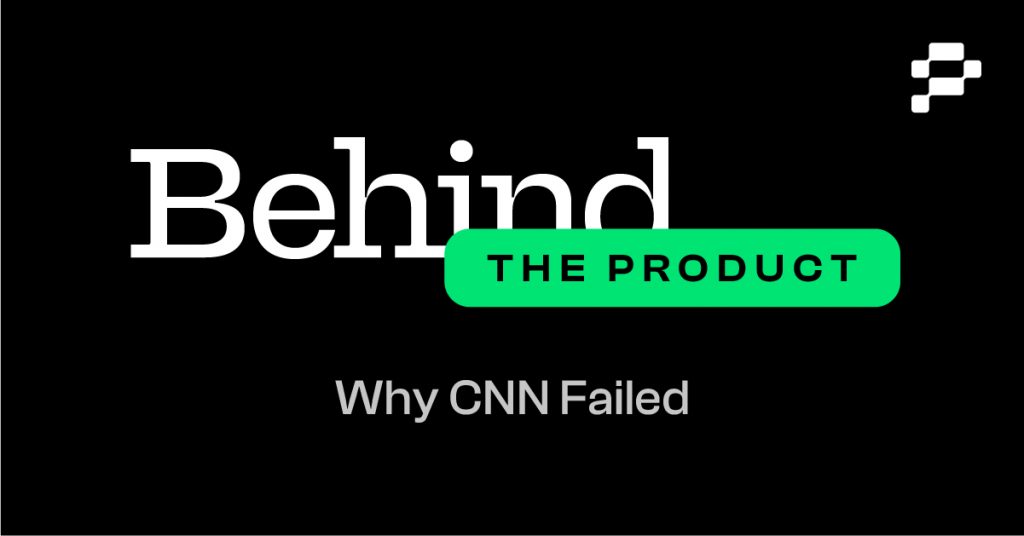
In our “Behind the Product” series, we discuss examples of products or services that highlight a particular Product Management concept or principle. As Product Managers, we’re constantly watching new and old products, and the marketing associated with them, to find examples for our training and materials that we can use to exemplify good, or not so good, practices in Product Management.
Since Netflix introduced streaming video on-demand (SVOD) back in 2007, the market has exploded. Sources of streaming content have proliferated, giving consumers a lot of choice and access to a lot of content. Just how popular are streaming services today? Nearly 80% of U.S. consumers use them, and the market is projected to reach over $932 billion by 2028.
But the tide is turning: Deloitte predicts that at least 150 million people will cancel their paid SVOD services in 2022, with churn rates of up to 30% per market.
It’s too bad that CNN didn’t figure that out before launching CNN+, a short-lived SVOD service and offshoot of the CNN cable television news network, which launched March 29, 2022 and was shut down less than a month after its debut. Talk about an epic fail – and an indication that Product Management principles and best practices may have been overlooked.
Where Are the Subscribers?
CNN+ originated with Jeff Zucker, the former president of WarnerMedia – CNN’s former parent company – as a way of helping CNN combat the decline in traditional cable viewership. CNN projected that the new SVOD service would attract two million subscribers by the end of 2022 and spent tens of millions of dollars to run a nationwide marketing campaign, hire hundreds of new employees, and sign on big-name anchors such as former Fox News Sunday host Chris Wallace.
But during the first two weeks, CNN+ only managed to sign on 150,000 subscribers. Compare that to Disney Plus, which attracted 10 million on its very first day. What’s more, Axios analyzed CNN’s potential viewership and found that CNN+ would have missed its goal by a wide margin, while spending about $400 million in the process.
So where were all the subscribers? Turns out they may be deciding which services to eliminate rather than looking for new ones to subscribe to. According to a recent survey conducted by Mohu, 57% of consumers are planning to cut some of their paid streaming subscriptions, and most will drop three out of five. Another survey found that more than 20% of U.S. consumers think they subscribe to too many streaming services – four or five, on average.
With consumers becoming overwhelmed with streaming choices and content, consolidation is inevitable. According to Chirs Licht, CNN’s new CEO and the person responsible for canceling CNN+, consumers now want “simplicity and an all-in-one service” rather than “standalone offerings.” Such consolidation is good for the provider and the consumer alike: consumers benefit from cost savings and ease of use, while providers can attract more subscribers and create stickiness.
What Went Wrong?
In short, the team that conceived of CNN+ failed to apply basic Product Management principles as they devised their offering:
- Market research: Prior to the CNN+ launch, Netflix was already showing signs of instability. In fact, the company lost 200,000 subscribers in Q1 2022. And let’s not forget that research conducted in 2021 was surfacing consumers’ changing sentiment toward subscribing to multiple services and the desire to switch to comprehensive, consolidated offerings. Had the team at CNN+ done its due diligence, it may have noticed indications that a new, niche streaming service would probably flop on the market.
- Stakeholder consideration: At the time CNN+ was being developed and launched, CNN’s executive team was undergoing big changes. Incoming CEO Licht was not involved in the decision-making process and had no input.
- Understanding the “Why”: Consumers sign up for streaming for one reason: cost-effective, seamless access to great content. Unfortunately, CNN+ didn’t offer any unique, show-stopping content that viewers couldn’t find anywhere else.
- Fulfilling the brand promise: CNN is an established brand with a definitive personality and a reputation for broadcasting news in real-time. However, CNN+ didn’t deliver on that promise. Due to network agreement with cable systems, it lacked what viewers expected: a live feed of breaking news stories.
By failing to incorporate the essential principles of Product Management into their product planning, CNN developed a service that no one would want or use, and that didn’t align with the business initiatives of new leadership taking the helm.
Optimize Your Next Product Introduction
CNN+ was a short-lived product failure that was doomed from the start – and the tragedy could have been avoided by applying smart Product Management principles and strategies throughout product development. Even if the team had decided to overlook Netflix’s subscriber woes and forge ahead with a new offering, better budgeting may have made the endeavor more worthwhile. They could have delayed launch until incoming leadership had time to weigh in, or tailored the offering to meet the needs of consumers and deliver on CNN’s brand promise. Having a solid understanding of these essential Product Management principles is of paramount importance when introducing a new product or service to market, no matter what the market conditions.
280 Group’s Optimal Product Management course teaches Product Managers at any stage in their career how to leverage key Product Management concepts and principles to not just avoid product failure, but to build and manage products that matter. Attendees also acquire the core skills needed to become a Certified Product Manager™ or Certified Product Marketing Manager™. Get started today!


